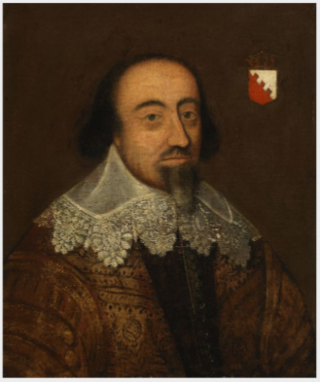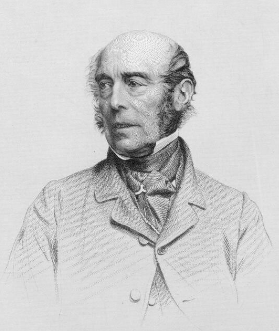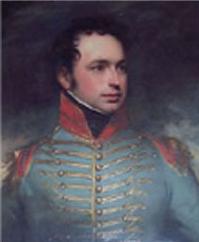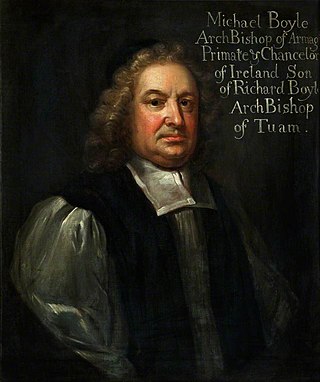This article needs additional citations for verification .(February 2015) |
| |||||
| Centuries: | |||||
|---|---|---|---|---|---|
| Decades: | |||||
| See also: | Other events of 1588 List of years in Ireland | ||||
Events from the year 1588 in Ireland.
This article needs additional citations for verification .(February 2015) |
| |||||
| Centuries: | |||||
|---|---|---|---|---|---|
| Decades: | |||||
| See also: | Other events of 1588 List of years in Ireland | ||||
Events from the year 1588 in Ireland.

Richard Boyle, 1st Earl of Cork, also known as the Great Earl of Cork, was an English politician who served as Lord Treasurer of the Kingdom of Ireland.

Earl of Cork is a title in the Peerage of Ireland, held in conjunction with the Earldom of Orrery since 1753. It was created in 1620 for Richard Boyle, 1st Baron Boyle. He had already been created Lord Boyle, Baron of Youghal, in the County of Cork, in 1616, and was made Viscount of Dungarvan, in the County of Waterford, at the same time he was given the earldom. These titles are also in the Peerage of Ireland.

Richard Boyle, 1st Earl of Burlington, 2nd Earl of Cork was an Anglo-Irish nobleman who served as Lord High Treasurer of Ireland and was a Cavalier.

Earl of Burlington is a title that has been created twice, the first time in the Peerage of England in 1664 and the second in the Peerage of the United Kingdom in 1831. Since 1858, Earl of Burlington has been a courtesy title used by the dukes of Devonshire, traditionally borne by the duke's grandson, who is the eldest son of the duke's eldest son, the marquess of Hartington.
Roger Boyle, 1st Earl of Orrery, styled Lord Broghill from 1628 to 1660, was an Anglo-Irish soldier and politician who sat in the House of Commons of England at various times between 1654 and 1679. Boyle fought in the Irish Confederate Wars and subsequently became known for his antagonism towards Irish Catholics and their political aspirations. He was also a noted playwright and writer on 17th-century warfare.

Charles FitzRoy, 2nd Duke of Grafton, was an Irish and English politician.

Ulick John de Burgh, 1st Marquess of Clanricarde, styled Lord Dunkellin until 1808 and The Earl of Clanricarde from 1808 until 1825, was a British Whig politician who served as British Ambassador to Russia (1838–40), Postmaster General (1846–52) and Lord Keeper of the Privy Seal (1858).

David Boyle, Lord Boyle FRSE was a British judge.

David Boyle, 7th Earl of Glasgow,, was a British naval commander and colonial governor. He served as Governor of New Zealand between 1892 and 1897.
Sir William FitzWilliam (1526–1599) was an English Lord Justice of Ireland and afterwards Lord Deputy of Ireland. In 1587, as Governor of Fotheringhay Castle, he supervised the execution of the death sentence on Mary, Queen of Scots. He was the Member of Parliament for Peterborough and represented County Carlow in the Irish House of Commons. He lived at Gainspark, Essex, and Milton Hall.

The Lords Justices were deputies who acted collectively in the absence of the chief governor of Ireland as head of the executive branch of the Dublin Castle administration. Lords Justices were sworn in at a meeting of the Privy Council of Ireland.
Armar Lowry-Corry, 1st Earl Belmore was an Irish nobleman and politician.

Colonel Henry George Herbert, 2nd Earl of Carnarvon DL, FSA, styled The Honourable Henry Herbert from 1780 to 1793 and Lord Porchester from 1793 to 1811, was a British peer, nobleman, and Whig politician.
George FitzGerald, 16th Earl of Kildare was known as the "Fairy Earl", apparently for no other reason than that his portrait, which is extant, was painted on a small scale."
The post of Lord President of Munster was the most important office in the English government of the Irish province of Munster from its introduction in the Elizabethan era for a century, to 1672, a period including the Desmond Rebellions in Munster, the Nine Years' War, and the Irish Rebellion of 1641. The Lord President was subject to the Lord Deputy of Ireland, but had full authority within the province, extending to civil, criminal, and church legal matters, the imposition of martial law, official appointments, and command of military forces. Some appointments to military governor of Munster were not accompanied by the status of President. The width of his powers led to frequent clashes with the longer established courts, and in 1622 the President, Donogh O'Brien, 4th Earl of Thomond, was warned sharply not to "intermeddle" with cases which were properly the business of those courts. He was assisted by a Council whose members included the Chief Justice of Munster, another justice and the Attorney General for the Province. By 1620 his council was permanently based in Limerick.

Michael Boyle, the younger was a Church of Ireland bishop who served as Archbishop of Dublin from 1663 to 1679 and Archbishop of Armagh from 1679 to his death. He also served as Lord Chancellor of Ireland, the last time a bishop was appointed to that office.
Sir William Parsons, 1st Baronet of Bellamont, PC (Ire), was known as a "land-hunter" expropriating land from owners whose titles were deemed defective. He also served as Surveyor General of Ireland and was an undertaker in several plantations. He governed Ireland as joint Lord Justice of Ireland from February 1640 to April 1643 during the Irish rebellion of 1641 and the beginning of the Irish Confederate War.
Henry Draycott was an English-born Crown official and judge in sixteenth-century Ireland, who held a number of senior Government offices, including Chancellor of the Exchequer of Ireland. Despite his apparent lack of legal qualifications, he also had a successful career as a judge, becoming a Baron of the Court of Exchequer (Ireland) and Master of the Rolls in Ireland. He became a substantial landowner in the Pale, with his principal estate at Mornington, County Meath.
Sir John Meade, 1st Baronet (1642–1707) was an Irish barrister, judge and politician. He was the first of the Meade Baronets of Balintubber, and an ancestor of the Earls of Clanwilliam. He was unusual among the lawyers of his time for his lack of ambition to become a judge of the High Court, despite being generally regarded as a barrister of "excellent parts (qualities)". In matters of religion, he seems to have been, by the standards of his time, a man of very tolerant views: although he was himself a Protestant, he damaged his career by marrying Elizabeth Butler, who was a Roman Catholic, as his third wife.
Henry Gosnold or Gosnell was an English-born lawyer who spent most of his very long life in Ireland. He sat in the Irish House of Commons and held office as Chief Justice of Munster and Deputy Admiralty judge for the same province. He is now mainly remembered for his friendship with Francis Bacon. He was also famous in his own lifetime for his wit: a few of his jokes still survive.